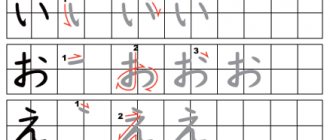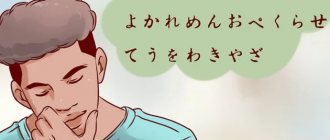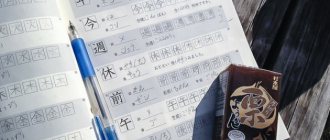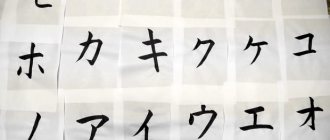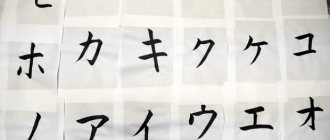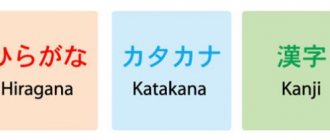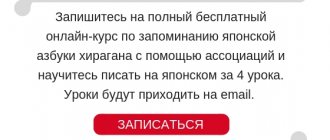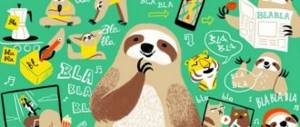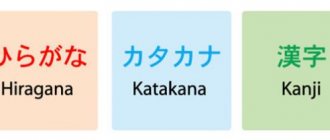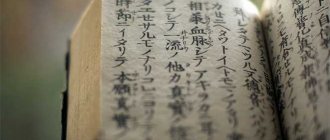Home / Japanese lessons / Hiragana
Hiragana (平仮名) is the Japanese syllabary, one of the components of Japanese writing along with katakana, hieroglyphs, Arabic numerals and Romaji (Roman alphabet). Hiragana and katakana together make up the kana system, in which one character expresses one mora. The kana sign can convey a vowel sound (for example, "a" あ); a combination of a consonant followed by a vowel (for example, “ta” た), or a nasal sonant “n” ん, which, depending on the context, can sound like Russian n, m, English ng or French nasal vowels. Hiragana is used for words that do not have kanji, including particles such as made まで and suffixes such as san さん.
Here you can:
- the entire Gojuon table of the Hiragana syllabary.
- View the order in which each syllable is written in the Hiragana alphabet.
- Download the copybook for each syllable of the Hiragana alphabet.
- Listen to the correct pronunciation.
- Read children's stories in hiragana
- Take the Hiragana knowledge test.
- New memory development game “Find the Pair” for Hiragana.
Where to begin?
If you are already familiar with all the hiragana characters, we recommend that you start by reviewing the basics. You have to find out the hiragana sign and choose the correct one from the list of answers. Proceed to the next section only if you are sure that you have a good memory of the Japanese writing characters. The tasks may seem difficult at first. Don't be afraid of mistakes! Practice regularly for 10-15 minutes a day, and within 2 weeks you will be able to achieve good results. Remember, hiragana is the basis of Japanese writing. The stronger your basic knowledge, the easier it will be for you at the first stage of studying at a language school.
| Basics of Hiragana Dakuten and Handakuten Almost all hiragana Yeon All hiragana Go to katakana |
Many thanks to Dmitry Budaragin (twitter) for the test. And also to Anton Gnatyuk for improving the test and creating new ones.
We write by hand
The ability to write hiragana remains essential to life in Japan, even though we increasingly use a keyboard or screen to type. Writing also develops reading skills, so practicing the alphabet signs is worth it. Japanese children learn through repetition, and while many use apps or other digital tools to learn hiragana characters, there's no better way than to sit down and write them down by hand. Examples of online study sheets can be found on the Chibimusu doriru website. This may be a good start for self-acquaintance with Japanese writing.
Elementary school teachers are usually strict about making sure that signs look absolutely correct and are written in the correct order. I personally think that writing order certainly needs to be learned early in the writing process (this applies to both katakana and kanji), but it's not that important as long as the end result is recognizable and looks uniform. However, it is worth keeping in mind that the correct type of sign may depend on the order and direction of writing the strokes; In addition, the incorrect order of writing strokes can cause problems with character recognition by the computer if you draw with your finger or stylus on a smartphone and tablet.
It is worth noting that some characters look different when written by hand and in printed form - for example, in printed き and さ the top and bottom parts are connected, while they are written with small gaps between the top part and the very bottom stroke ( see table below).
Hiragana and script characters
Features of the table
- Spell the sign by clicking on the picture,
- Copybooks in PDF format.
| A | And | at | uh | O |
| ka | ki | ku | ke | co |
| sa | si | su | se | with |
| that | you | tsu | te | That |
| on | neither | Well | ne | But |
| Ha | hee | ugh | heh | xo |
| ma | mi | mu | meh | mo |
| I | Yu | e | ||
| ra | ri | RU | re | ro |
| va | n | o (pad.) |
(RTF, 219K) Go to katakana
Japanese alphabet Hiragana
Japanese alphabet hiragana. Click on the picture to enlarge it. If you are interested in learning Japanese, you have probably heard the word “hiragana”.
What is it? Hiragana is one of the syllabary alphabet of the Japanese language , and there are two of them. The second alphabet is called “katakana” and we will talk about it in the next article.
So, the Hiragana alphabet is used to write native Japanese words, as well as Japanese names.
Hiragana in Japanese is also used instead of kanji when it is assumed that the reader does not know any kanji. The reading of hieroglyphs is also written with hiragana signs above or below the words. For example, 大学(だいがく) /daigaku/ daigaku – “institute”. This reading of hieroglyphs is called “furigana”.
As mentioned above, the Hiragana alphabet is a syllabic alphabet, and this means that one letter or sign contains 2 sounds, i.e. a syllable.
In hiragana, as in katakana, there are also signs that contain only one sound - a vowel. This is the very first row of characters from the あ(a) sign to the お(o) sign. In the last row there are also 2 characters in which there is only one sound - this is another sign を (o). Thus, there are 2 characters in hiragana that are read as “o” - お and を.
When are these signs used? The sign お (o) from the first row is written in words, for example, おはようございます /ohayo:gozaimas(u) / ohayo:gozaimas(u) / “good morning”, and the sign を (o) from the last row of hiragana is used as grammatical particle, which is also called the indicator of the accusative case, and is never written in words. For example, ほんを よみます/ hon o yomimas(u) / hon o yomimas(u), where the word ほん/hon/hon means “book”, よみます/yomimas(u) /yomimas(u) – “read”, i.e., this phrase completely means “read (who? what? – blame. case) book.” を is not translated.
And there is another sign in which there is only one sound - this is the very last hiragana character - the sign ん / n / n.
I would also like to draw your attention to 2 signs from the 6th row of the table. They are similar and differ only in some details. This is the first character of this series - は / ha / ha and the last character of the same series - the sign ほ / ho / ho:
は - ほ
The sign は / ha / ha has one horizontal line in the upper right part, and a vertical line intersects it. The sign ほ / ho / ho has two horizontal lines in the upper right part, and the vertical line does not intersect the upper horizontal line.
In addition, as practice has shown, those starting to study hiragana very often get confused in writing the following characters, since they are very similar:
あ /a-お/o
き / ki / ki -さ / sa / sa
ぬ / nu / well-め / me / me
は / ha / ha -ほ / ho / ho -ま / ma / ma
ね / ne / ne -れ / re / re -わ / wa / wa
る / ru / ru-ろ / ro / ro
Be careful when writing these signs!
If you are just starting to learn Japanese and want to learn hiragana, katakana, and also want to learn how to write words in Japanese and construct sentences in Japanese, then sign up for free video lessons <<<here>>> .
If you already know both hiragana and katakana, did you find it difficult to remember these characters? How did you remember similar signs? Share your experience in the comments below!
This is a useful read:
- Following in the footsteps of the Photobiennale 2016: Utopias. Part 1
- Participle of simultaneity of action
- Use of verbs 知る/shiru/ “to know” and 分かる/wakaru/ “to understand”
Yotsugana[ | ]
Main article: Yotsugana
There are two hiragana characters pronounced ji
(じ and ぢ) and two characters pronounced as
zu
(ず and づ).
These pairs are not interchangeable. Usually ji
is written as じ, and
zu
as ず, but there are exceptions.
If in a word the first syllable is written with a sign without nigori
, and the second syllable can be written with the same sign, but with
nigori
, then the same hiragana sign is used to write them.
For example, chijimeru
(“to shed”, “to shorten”) is written as ちぢめる.
In compound words where nigori
reflects the
rendaku
, the original hiragana sign is also used.
For example, ti
(血 “blood”) is written and sounds like ち.
When the kanji 血 and 鼻 ( hana
, "nose") are combined to form the word
hanaji
(鼻血 "nosebleed"), the sound 血 changes from
ti
to
ji
.
Thus, Hanaji
is written in hiragana as はなぢ, that is, the same hiragana character is used to write the character 血.
Likewise, tsukau
(使う; "use") is written in hiragana as つかう, so
kanazukai
(かな使い; "kana use" or "kana spelling") is written in hiragana as かなづかい.
However, this rule does not apply when kanji are used to create words whose meaning cannot be learned from a literal reading of the characters. For example, the word inazuma
(稲妻, flash of lightning) consists of the kanji
ina
稲 ("rice", written as いな) and
tsuma
妻 ("wife", separately written in hiragana as つま, in a multi-kanji word as ずま
zuma
). Since its meaning cannot be directly guessed from this combination, it is usually written in hiragana as いなずま rather than いなづま.
Hiragana alphabet[ | ]
Hiragana is based on a basic set of characters, goju: it from which additional sounds can be formed. When adding a dakuten
, or
nigori
, (゛), the voiceless consonant
t is voiced
into the voiced consonant
d
, respectively
, k
goes into
g
,
s
→
dz
,
x
→
b
.
Hiragana characters beginning with x
can also be appended with a
handakuten
(゜), which changes the
x
to
p
.
There are diminished signs for the sounds i
,
yu
and
yo
(symbols ゃ, ゅ and ょ respectively).
When they are added to syllables ending in and
, their ending is replaced by a smooth palatalization.
This addition is called e: he
.
The reduced sign tsu
っ, called
sokuon
, denotes gemination (doubling) of a consonant. It occurs before fricative and stop consonants, and sometimes at the end of sentences. In Polivanov's system, this sign is displayed by doubling the subsequent consonant.
In informal writing, reduced vowel marks are sometimes used to convey a decaying sound (はぁ, ねぇ).
Some hiragana characters are rarely used. Vi signs
ゐ and
ve
ゑ have been abolished and are not used in writing.
The sign ゔ is an innovation designed to express the hard "v" sound in foreign languages, but since there is no such sound in Japanese, it is often pronounced as b
. This character is rarely used since loanwords (gairaigo) and transliterations are usually written in katakana.
Japanese questions derived from certain meanings
- 何語 - なにご - Nanigo - what language?
- 何回 - なんかい - Nankai - how many times?
- 何階 - なんがい - Nangai - what floor?
- 何時 - なんじ - Nanji - what time is it?
- 何番 - なんばん - Nanban - what number? what size?
- 何分 - なんぷん - Nanpun - how many minutes?
- 何曜日- なんょうび - Nanyoubi - what day of the week?
- 何月 - なんがつ - Nangatsu - what month?
- 何日- なんにち - Nannichi - what day? (according to calendar)
- - なんばんせん - Nanbansen - which way? (at the railway station)
- 何人 - なんにん - Nanin - how many people?
- 何時に - なんじに - Nanjini - what time?
- 何時から 何時まで - Nanjikara nanjimade - from what time to what time
Pronouns in Japanese
- 私ーわたし - Watashi - I
- 私たち - わたしたち - Watashi tachi - We
- 彼 - かれ - Kare - He
- 彼女- かのじょ – Kanojo – She
- あの方 - あのかた - Anokata (polite) - He, she
- あの人 - あのひと - Anohito - He, she
- 彼ら -かれら – Karera – They
- ー あなた - Anata - You, you
- 皆さん - みなさん - Minasan - everything, everything
- 皆 - みんな - Min'na - everyone (neutral)
- みんなで - Min'nade - all together
To make a possessive from a personal pronoun, just add a postposition の / No
- 私のーわたしの - Watashi no - Mine
- 彼の - かれの - Kareno - His
- 彼女の - かのじょの - Kanojono - Her
- ー あなたの - Anatano - Yours
- 私たちの — わたしたちの — Watashitachino — Ours
Notes[ | ]
- Soviet encyclopedic dictionary / Scientific ed. advice: A. M. Prokhorov (pres.). - M.: Soviet Encyclopedia, 1981. - P. 1592. - 1600 p. — 1,200,000 copies.
- Lavrentyev B.P.
Self-instruction manual of the Japanese language. — 5th ed., rev. - M.: Living Language, 2002. - S. . — 352 p. — 3050 copies. — ISBN 5-8033-0141-8. - Bjarke Frellesvig.
A history of the Japanese language. - Cambridge; New York: Cambridge University Press, 2010. - ISBN 978-0-521-65320-6. - Unicode Consortium.
The Unicode Standard 12.1 - Small Kana Extension ❰ Range: 1B130—1B16F ❱ (English).
Unicode.org
(2019). Access date: June 25, 2021. - Lenta.ru.
The oldest examples of hiragana (Russian) discovered (11/30/2012). Access date: November 30, 2012. - Song "Iroha". Translation by N. I. Conrad.
Nouns
| Word in Japanese | Writing in Hiragana | Transcription | Translation |
| 日本 | にほん | nihon | Japan |
| 日本語 | にほんご | nihongo | Japanese |
| 人 | ひと | hito | Human |
| 男 | おとこ | otoko | man |
| 女 | おんな | He is at | woman |
| 子 | こ | co | child |
| 日 | ひ | hee | day |
| 月 | つき | tsuki | month |
| 年 | とし | tosi | year |
| 朝 | あさ | asa | morning |
| 昼 | ひる | Hiru | day |
| 本 | ほん | hon. | book |
| 映画 | えいが | Eiga | movie |
| 仕事 | しごと | shigoto | Job |
| 学校 | がっこう | gakko: | school |
| 大学 | だいがく | daigaku | university |
| 遊び | あそび | asobi | game, entertainment |
| 家 | いえ | ie | house |
| ベッド | べっど | baddo | bed |
| 机 | つくえ | tsukue | table |
| 椅子 | いす | isu | chair |
| ペン | ぺん | pen | pen |
| 鉛筆 | えんぴつ | empitsu | pencil |
| 紙 | かみ | kami | paper |
| 絵 | え | uh | image |
| 鞄 | かばん | boar | briefcase |
| お金 | おかね | okane | money |
| シャツ | しゃつ | syatsu | shirt |
| ズボン | ずぼん | dzubon | trousers |
| ジーンズ | じいんず | ji:nsu | jeans |
| ブラウズ | ぶらうず | burauzu | blouse |
| スカート | すかあと | ska:to | skirt |
| 靴 | くつ | kutsu | shoes |
| 靴下 | くつした | kutsushita | socks |
| 車 | くるま | kuruma | car |
| 地下鉄 | ちかてつ | chikatetsu | metro |
| 自転車 | じてんしゃ | jitensha | bike |
| バス | ばす | bass | bus |
| タクシー | たくしい | takushi: | Taxi |
| 飛行機 | ひこうき | hiko:ki | airplane |
| 猫 | ねこ | neko | cat |
| 犬 | いぬ | inu | dog |
| ペット | ぺっと | petto | pet |
| 動物 | どうぶつ | to:butsu | animal |
| 果物 | くだもの | kudamono | fruit |
| 野菜 | やさい | yasai | vegetables |
| りんご | りんご | ringo | apple |
| 梨 | なし | naxi | pear |
| 柿 | かき | kaki | persimmon |
| バナナ | ばなな | banana | banana |
| いちご | いちご | ichigo | strawberry |
| トマト | とまと | tomato | tomato |
| ご飯 | ごはん | go-han | boiled rice |
| 牛乳 | ぎゅうにゅう | gyu:nu: | milk |
| 卵 | たまご | tamago | egg |
| 魚 | さかな | sakana | fish |
| お肉 | おにく | oh no | meat |
| 料理 | りょうり | ryo:ri | dish, kitchen |
| 食べ物 | たべもの | tabemono | food |
| 飲み物 | のみもの | nomimono | drink |
| 水 | みず | mizu | the water is cold) |
| ジュース | じゅうす | ju:su | juice |
| お茶 | おちゃ | oh-cha | tea |
| コーヒー | こうひい | ko:hee: | coffee |
| ケーキ | けえき | ke:ki | cake |
Questions in Japanese
- - おいくつ - O ikutsu - how old? (polite style)
- 何歳 - なんさい - Nansai - how old?
- 誰 - だれ - Dare - who?
- 誰の - だれの - Dareno - whose?
- - どなた - Donata - who? (politely)
- 何時ですか — なんじですか — Nanjidesuka — what time is it?
- -いつですか - Itsudesuka - when? (polite style), in neutral it will be - いつ? — Itsu
- どの - Dono - which one?
- 何 - なに, なん - Nani, Nan- what?
- 何で - なんで - Nande - on what? (to the words いきます、きます、かえります / go (go), come, return)
- 何と - なんと - Nanto - with whom?
- -どのくらい - Donokurai - how long? how far? How many?
- -どこで — Dokode — where?
- -なぜ - Naze - why?
- -どやって - Doyatte - how, in what way?
- -いみは - Imiwa - what is the meaning?
- -いくら - Ikura - how much does it cost?
- -どちら - Dochira - where? where? which?
- -どこへ - Doko e (e) - where?
- -どこへも/どこも - Doko e mo/ dokomo - nowhere
- -どう - Dō - how?
- -どんな - Don'na - which one? what the?
- -どうして - Dōshite - why?
- -いかが - Ikaga - how?
- どう するの? - Dō suruno - what will you do? (neutral style)
- どう しようかな? - Dō shiyoukana - what should I do?
Pronunciation rules[ | ]
With minor exceptions for the particles は, を and へ, which in some cases are pronounced wa
,
o
and
e
respectively, hiragana characters are read according to the table above.
Before the Meiji reforms, pronunciation rules were more complex (see historical use of kana). Modern exceptions are a legacy of the old system. The exact pronunciation rules are called kanazukai
(仮名遣い), "the use of kana."
In hiragana, vowel length is usually expressed by adding a vowel to the previous syllable. For vowels a
,
and
,
у
the corresponding separate vowel is added:
- a (Japanese あ) - “mother” (Japanese おかあさんoka:san
), - and (Japanese い) - “Niigata” (Japanese にいがた),
- u (Japanese う) - “to eat, eat” (Japanese くうku
:).
Occasionally duplication is used for e
and
o
: “elder sister” (Japanese: ねえさん
ne:san
), “big” (Japanese: おおきい
o:kii
).
Usually the longitude “e” is indicated by adding and (Japanese い) - “order, command” (Japanese めいれいmeirei
), and “o” - by adding u (Japanese う) - “king” (Japanese おうさま
o: herself
). The vowel lengthening character chōon (ー), used in katakana, is rarely used with hiragana, for example in the word らーめん (ramen), but this use is non-standard.
A word cannot begin with kana ん ( n
), this, for example, is the basis of the game shiritori.
However, n
can be followed by a vowel.
For example, ren'ai
(恋愛, "love") is written in hiragana as れんあい (the word *
renai
れない does not exist).
Before the consonants p
,
b
and
m,
the sound
n
is pronounced as
m
, which is usually noted when transmitting Japanese text in Cyrillic.
For example, shimbun
(新聞, "newspaper") is written in hiragana as しんぶん (
shi-n-bu-n
).
